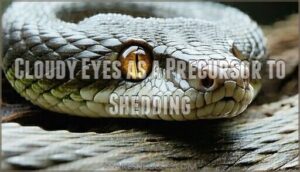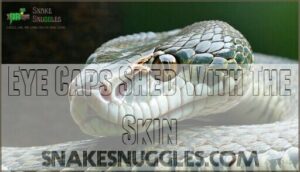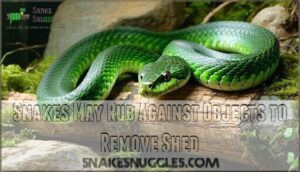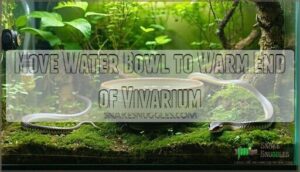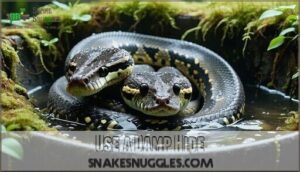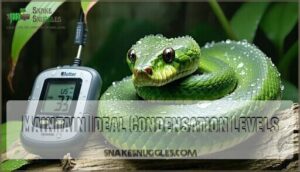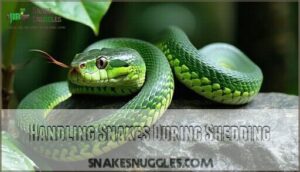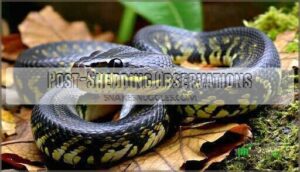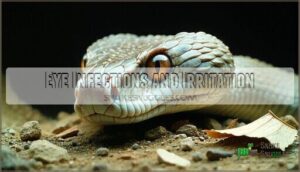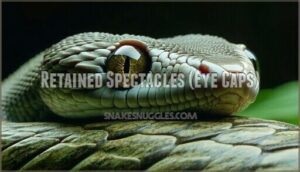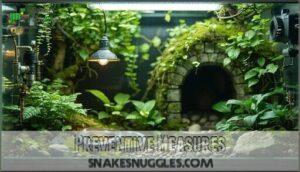This site is supported by our readers. We may earn a commission, at no cost to you, if you purchase through links.
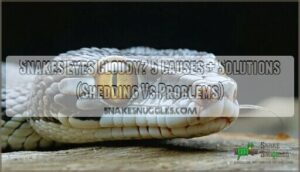 If you’re wondering why your snake’s eyes are cloudy, you’re likely witnessing the natural shedding process.
If you’re wondering why your snake’s eyes are cloudy, you’re likely witnessing the natural shedding process.
Snakes develop a milky, opaque appearance in their eyes about a week before shedding their skin.
This happens because fluid builds up between the old and new eye caps.
However, cloudy eyes can also signal problems like retained eye caps, infections, or dehydration.
During normal shedding, both eyes cloud simultaneously and clear up after the snake sheds.
If only one eye stays cloudy, or if cloudiness persists after shedding, you’re dealing with a health issue that needs attention.
Understanding the difference between normal shedding and actual problems can save your snake from complications.
Table Of Contents
- Key Takeaways
- Causes of Cloudy Eyes in Snakes
- The Shedding Process
- Managing Humidity for Shedding
- Handling Snakes During Shedding
- Post-Shedding Observations
- Eye Infections and Irritation
- Retained Spectacles (Eye Caps)
- Preventive Measures
- Frequently Asked Questions (FAQs)
- Why are my snakes’ eyes cloudy?
- Are snake eyes supposed to be cloudy?
- How to treat snake eye infection?
- Why does my snake have cloudy eyes?
- Why are my snake eyes gray?
- How long does it take a snake to shed once eyes are cloudy?
- What is wrong with my snakes eye?
- Why do snakes have cloudy eyes?
- Do snakes have eyelids?
- How do you know if a snake has eye holes?
- Conclusion
Key Takeaways
- You’ll see cloudy eyes 7-10 days before shedding – this milky appearance in both eyes is completely normal as fluid builds between old and new skin layers, temporarily reducing your snake’s vision until they shed.
- Increase humidity to 60-70% when eyes cloud over – proper moisture prevents retained eye caps and complications, so mist the enclosure lightly, move the water bowl to the warm side, and provide a damp hide.
- Don’t handle your snake during the cloudy-eye phase – they’re vulnerable, may refuse food, and can become defensive due to impaired vision, so minimize interaction until after they’ve completed shedding.
- Persistent cloudiness after shedding signals a problem – if only one eye stays cloudy, cloudiness doesn’t clear post-shed, or you notice discharge and behavioral changes, you’re dealing with an infection or retained eye caps that need veterinary attention.
Causes of Cloudy Eyes in Snakes
You’ll notice your snake’s eyes becoming cloudy or milky for several reasons, with shedding being the most common and normal cause.
Other factors like infections, dehydration, or environmental irritants can also create this cloudy appearance and require different solutions.
Shedding Process
During the snake shedding process, your pet’s eyes turn cloudy as ecdysis signals begin.
This vision impairment occurs from lymphatic buildup between old and new skin layers.
The shedding duration typically lasts 5-14 days.
Your snake will seek rough surfaces to remove old skin and eye caps, which naturally shed together during this normal process.
Eye Infections
Not all cloudy eyes signal shedding. When bacterial infections, fungal infections, or parasitic infections take hold, your snake’s eyes can develop a persistent haze that won’t clear naturally.
Not all cloudy eyes mean shedding is coming—infections create stubborn haze that won’t clear on its own.
Poor husbandry creates perfect conditions for these problems to flourish.
Watch for these warning signs beyond cloudiness:
- Discharge or swelling around the eye area
- Behavioral changes like increased agitation or reduced appetite
- Corneal ulcers that appear as white or yellow spots
Snake eye infections often stem from dirty enclosures, inadequate humidity, or vitamin deficiency. Ocular infections require immediate veterinary attention since they can lead to permanent vision loss or systemic illness if left untreated.
Retained spectacles may also indicate incomplete shedding.
Dehydration
When your snake’s water reserves run low, snake eye cloudiness becomes a telltale sign.
Dehydration affects skin elasticity and creates that hazy appearance you’re seeing.
| Dehydration Signs | Solutions |
|---|---|
| Cloudy, sunken eyes | Increase humidity to 60-70% |
| Wrinkled, dry skin | Provide larger waterbowl |
| Loss of skin elasticity | Boost misting frequency |
| Lethargy, appetite loss | Monitor hydration levels daily |
Water availability directly impacts snake eye dehydration.
Insufficient humidity prevents proper hydration through skin absorption.
You can check for dehydration by observing the skin’s elasticity, which should quickly return to normal after being gently pinched.
Environmental Irritants
Beyond dehydration lurks another threat to your snake’s eye health.
Environmental irritants like dust exposure, chemical sprays, and mite infestation can trigger snake eye cloudiness. Substrate irritation from poor-quality bedding and contaminated water quality create hostile conditions.
These environmental irritants attack your snake’s delicate eye tissues, causing inflammation and discomfort.
- Dust particles settling on eye caps create persistent irritation
- Chemical residues from cleaning products burn sensitive eye tissues
- Mite infestations cause relentless scratching and secondary infections
Regular habitat maintenance prevents most irritant-related problems.
The Shedding Process
Most snakes develop cloudy eyes 7-10 days before shedding as fluid builds between old and new skin layers.
You’ll notice this milky appearance affects both eyes equally, signaling your snake’s natural molting process has begun.
Cloudy Eyes as a Precursor to Shedding
When your snake’s eyes turn cloudy, it’s like watching nature’s magic unfold.
This preshed phase signals shedding frequency is approaching, typically every 4-8 weeks.
Lymphatic fluid builds between old and new skin layers, creating that milky appearance.
Vision impairment follows, along with temperament changes and skin dullness.
Your snake becomes more defensive and may refuse food.
| Shedding Stage | Eye Appearance | Snake Behavior |
|---|---|---|
| Pre-shed (Days 1-3) | Cloudy/milky | Defensive, hiding |
| Mid-shed (Days 4-7) | Very cloudy | Reduced appetite |
| Pre-molt (Days 8-10) | Clearing up | Increased activity |
| Clear eyes (Days 11-12) | Crystal clear | Ready to shed |
| Post-shed (Day 13+) | Bright, clear | Normal behavior |
This natural process requires patience and proper humidity management for healthy eye caps removal.
Eye Caps Shed With The Skin
Your snake’s eye caps are transparent scales that protect each eye like built-in goggles.
These spectacles shed with the rest of the skin during healthy shedding cycles.
Eye cap function involves blocking debris while allowing vision.
The spectacle composition includes thick protective layers that maintain moisture.
After shedding frequency completes, conduct a post-shed check to verify snake eye caps removal occurred properly, preventing retained eye caps and snake shedding problems.
Retained eye caps can occur due to low humidity or dehydration, which may lead to snake shedding problems and require special attention to prevent complications related to healthy shedding cycles.
Snakes May Rub Against Objects to Remove Shed
As the eye caps prepare to shed, your snake’s rubbing behavior kicks into high gear.
This natural instinct helps loosen the old skin and eye caps through friction against rough surfaces in their habitat.
You’ll notice increased rubbing frequency as shedding approaches, which is perfectly normal for addressing cloudy snake eyes and snake shedding problems.
Smart enclosure enrichment means providing appropriate shedding substrate like branches, cork bark, or textured rocks.
These surfaces support natural behaviors while preventing snake eye problems.
However, injury prevention remains key – avoid sharp edges or abrasive materials that could damage delicate skin during this vulnerable time.
Proper habitat setup helps prevent retained eye caps and other complications.
Managing Humidity for Shedding
When your snake’s eyes turn cloudy, proper humidity becomes essential for a smooth shed.
You’ll need to create the right moisture conditions to help your snake successfully remove its old skin and eye caps.
Mist Enclosure Lightly With Lukewarm Water
Proper humidity levels prevent complications when your snake shows cloudy snake eyes during snake shedding.
The misting techniques using lukewarm water create ideal conditions for snake eye care.
The lukewarm benefits include gentle moisture that won’t shock your pet. Water temperature should feel comfortable to your touch.
Misting frequency depends on your enclosure’s humidity impact – light, regular spraying helps resolve snake eye problems naturally without creating excessive moisture that promotes mold growth.
Move Water Bowl to Warm End of Vivarium
Repositioning your snake’s water bowl to the warm side creates a humidity gradient that supports healthy shedding.
Water evaporation increases when placed near heat sources, raising ambient humidity levels naturally.
This setup encourages proper snake hydration while maintaining temperature regulation throughout the enclosure.
- Strategic placement prevents bacterial growth – warmer water circulates better and stays fresher longer
Monitor water quality regularly, as increased evaporation concentrates impurities.
Clean environmental conditions prevent cloudy snake eyes and other snake eye conditions.
This simple adjustment addresses snake dehydration effectively, creating ideal environmental conditions for your pet’s shedding cycle without complicated equipment.
Use a Damp Hide
A damp hide creates a perfect microenvironment for your snake during shedding periods.
Set up this specialized shelter on the warm side of your enclosure using moisture-retaining substrate like sphagnum moss.
You’ll want to maintain proper ventilation to prevent mold while keeping humidity levels high.
| Damp Hide Benefits | Hide Material Choice |
|---|---|
| Prevents retained eye caps | Sphagnum moss holds moisture |
| Reduces shedding stress | Paper towels work temporarily |
| Maintains local humidity | Coconut fiber retains dampness |
| Provides secure retreat | Avoid materials that mold easily |
Your snake will instinctively seek out this humid refuge when cloudy eyes signal approaching shedding.
Location matters – place it where your snake feels most secure while accessing the warmth needed for proper skin removal.
Consider a pre-made moss hide for convenience.
Maintain Ideal Condensation Levels
Mastering humidity control becomes your secret weapon for successful snake shedding. You’ll need a digital hygrometer to monitor precise moisture levels and maintain the best environmental conditions. Watch your water evaporation rate carefully, adjusting when necessary to maintain consistent hydration importance for your snake’s comfort and health.
- Humidity monitoring with digital tools for accurate readings
- Misting frequency adjusted based on your snake’s shedding cycle
- Water bowl placement in warm zones for better evaporation control
Perfect condensation levels prevent retained eye caps and keep your snake eyes cloudy only during natural shedding periods, not from problematic environmental conditions.
Handling Snakes During Shedding
When your snake’s eyes turn cloudy, it’s entering the pre-shedding phase and becomes more vulnerable to stress.
You’ll need to minimize handling during this time since your snake may refuse to be touched and won’t eat until the shed is complete.
Minimize Handling
When your snake’s eyes turn cloudy, it’s time to reduce stress by limiting interaction with your pet.
Avoid injury by keeping handling to a minimum during the shedding process.
Observe behavior changes like increased hiding or defensive postures that signal vulnerability.
Gentle handling becomes essential if you must move your snake for cleaning or health checks.
Snake eye problems often worsen with excessive contact, so snake eyes cloudy conditions require patience.
Snake eye treatment starts with proper snake handling techniques that prioritize your pet’s comfort.
Remember, snake eye care means respecting your snake’s natural shedding cycle through reduced contact.
This approach ensures the well-being of your pet and supports a healthy shedding process, which is crucial for reducing stress.
Be Gentle Due to Vulnerability
Beyond minimizing handling, your snake’s delicate condition during shedding requires extra care.
Handle with gentle handling techniques to avoid stress and minimize trauma to vulnerable skin. Your snake’s cloudy eyes and reduced snake vision make it easily startled, so reduce interaction whenever possible.
Follow these snake eye care guidelines:
- Use soft surfaces when placing your snake down to prevent skin damage
- Support the body evenly with slow, deliberate movements
- Keep sessions brief to prevent overwhelming your already uncomfortable pet
Watch for snake eye problems and snake eye health changes during this sensitive period.
Snakes May Refuse Handling
Why do snakes refuse handling during shedding? Handling refusal is your snake’s natural response to shedding stress and vulnerability concerns.
Temperament changes occur as snake vision issues impair their ability to assess threats.
Minimize interaction during this sensitive period to prevent snake eye problems from worsening. Respect their need for space—forced handling can escalate snake eye symptoms and snake behavior changes.
Treating cloudy eyes starts with reducing stress through gentle care.
Snakes May Not Eat During Shedding
During shedding, your snake’s appetite naturally decreases as its body conserves energy for the molting process. This reduced activity and energy conservation help manage the physical stress of renewal.
Stress reduction occurs when you avoid forcing meals during this vulnerable period. Digestive changes accompany snake vision issues and other shedding symptoms.
Here’s what happens during shedding appetite loss:
- Body prioritizes skin renewal over digestion
- Snake health depends on this natural fasting
- Snake eye symptoms signal feeding changes ahead
- Forcing food creates unnecessary stress
- Normal appetite returns post-shed
Monitor your snake’s condition without intervening.
Post-Shedding Observations
Once your snake completes shedding, you’ll notice several clear signs that the process was successful.
The most obvious change is that your snake’s eyes will return to their normal clear appearance, and its skin will regain its bright, vibrant colors.
Eyes Clear
Clear windows replace cloudy barriers as your snake completes its shedding timeline.
This post-shed clarity marks complete shedding success and vision restoration with intact eye cap integrity.
The transformation from ocular opacity to crystal-clear snake eye appearance signals your pet’s return to normal health.
Snake eye clarity indicators include:
- Snake eyes regain transparent appearance
- Cloudy eyes disappear completely
- Visual acuity returns to normal
- Activity levels increase noticeably
Your snake’s renewed alertness confirms successful molting completion.
Skin Brightens
Once your snake’s eyes clear, you’ll notice a dramatic transformation in their skin texture.
The dull, faded appearance gives way to vibrant colors and a healthy glow that showcases your pet’s natural beauty.
This scale sheen signals successful shed completion, revealing fresh skin underneath.
The renewed snake eye appearance and ocular opacity clearing indicate your snake’s shedding process worked perfectly, restoring normal snake eye clarity.
Increased Activity
After your snake completes shedding, you’ll notice a dramatic exploration increase in their behavior.
This renewed energy signals successful molting and healthy hunting behavior. Your pet will actively patrol their territory, displaying normal snake behavior monitoring patterns.
Watch for territory marking movements and increased appetite as signs of recovery.
This stress response reversal shows their snake eyes have cleared properly, eliminating the cloudy eyes that limited their vision during shedding.
Check for Retained Shed
Once your snake completes shedding, you’ll need to perform a thorough Post-Shed Inspection to confirm everything went smoothly.
Here’s your Complete Shed Check process:
- Examine the eye caps – Look for retained eye caps that didn’t shed properly
- Inspect Scale Abnormalities – Check for Shedding Imperfections on the tail and body
- Check Eye Health – Verify eyes are clear and bright after snake shedding
Proper humidity prevents most retention issues during the shedding process.
Eye Infections and Irritation
If your snake’s eyes stay cloudy after shedding, you’re likely dealing with an infection or irritation that needs immediate attention.
Eye infections can develop from bacteria, environmental irritants, or poor humidity levels in the enclosure.
Symptoms: Cloudy Eyes, Agitation, Altered Movement
When your snake’s eyes appear cloudy, watch for additional warning signs that reveal the underlying cause.
Cloudy eyes paired with agitation signals potential snake eye problems beyond normal shedding. You’ll notice defensive behavior, excessive hiding behavior, and reduced appetite during these episodes.
Pre-shedding anxiety creates temporary vision impairment, while skin dullness accompanies natural molting.
However, persistent snake symptoms like erratic movement or continued cloudiness indicate snake eye infections requiring immediate attention.
Monitor these snake eye issues closely to distinguish between normal shedding and serious health concerns.
Possible Causes: Infections, Irritants, Low Humidity
Multiple culprits can trigger cloudy eyes beyond normal shedding.
Bacterial infections from poor husbandry create painful Eye Ulcers and Corneal Lesions. Environmental irritants like substrate dust cause inflammation, while Mite Infestation leads to secondary infections.
Vitamin Deficiency weakens immune defenses, and Duct Blockage traps fluid. A key factor can also be retained eye caps, which may indicate shedding issues.
- Your snake’s cloudy eyes signal distress that demands immediate attention
Immediate Care: Wipe Eyes, Increase Humidity, Clean Enclosure
Once you’ve identified the potential causes, quick action helps prevent complications.
Gently wipe your snake’s eyes with a damp cotton ball to remove debris or discharge.
Boost humidity levels through misting and provide a larger water bowl for soaking.
Clean the enclosure thoroughly with reptile-safe disinfectant to eliminate irritants.
For specialized cleaning, consider using pre-moistened snake wipes.
Monitor your snake daily during this observation period to track improvement and guarantee proper snake eye care with reptile-safe methods.
Retained Spectacles (Eye Caps)
Sometimes your snake’s eye caps don’t shed properly, leaving old scales stuck over their eyes like contact lenses that won’t come out.
You’ll notice empty eye holes in the shed skin or persistent cloudiness after shedding, which can lead to vision problems and infections if not addressed.
Definition: Scales Over Eyes That Do Not Shed
Without proper shedding, your snake’s spectacles can become stuck over their eyes.
These transparent scales, also called eye caps, normally shed with the rest of the skin during the snake shedding cycle.
When spectacle retention occurs, the old scales remain attached instead of falling off naturally.
This incomplete shedding creates scale abnormalities that affect your snake’s ocular health.
Retained eye caps happen when humidity levels drop too low or dehydration weakens the shedding process.
Don’t try removing them yourself—improper handling can damage delicate eye tissue permanently.
Symptoms: Empty Eye Holes, Cloudy Eyes, Refusal to Eat
You’ll spot retained spectacles when your snake’s shed skin shows empty eye holes where the cloudy eyes should have cleared.
This vision impairment triggers behavioral changes like food refusal and increased hiding.
Snake eye problems persist beyond normal shedding frequency, causing ongoing snake health concerns.
These snake eye symptoms can lead to blindness if untreated.
Veterinary consultation becomes necessary when hydration importance and proper husbandry don’t resolve the issue.
Causes: Lack of Humidity, Dehydration, Malnutrition
Several factors cause retained eye caps in snakes. Low humidity prevents proper shedding, while dehydration weakens the snake’s ability to shed completely.
Malnutrition and vitamin deficiency also contribute to snake eye problems and potential snake blindness causes. Poor water availability compounds these issues.
Snakes with this issue may benefit from acetylcysteine treatment to soften stubborn eye caps.
Humidity effects and dehydration signs include:
- Your snake’s eyes stay cloudy after shedding attempts
- The skin appears wrinkled or doesn’t come off in one piece
- Malnutrition impact shows through dull coloration and lethargy
- Multiple shedding cycles fail, creating dangerous eye cap buildup
Treatment: Veterinary Removal, Soaking, Tape Removal
When dealing with retained eye caps, veterinary intervention remains your safest bet. Professional snake eye treatment prevents permanent damage that DIY attempts might cause.
Lukewarm soaks for 10-30 minutes can soften stubborn caps. Place your snake in shallow water, then gently dry before attempting removal. A shedding box with damp substrate helps maintain humidity between treatments. A specialized shedding enclosure can further aid in the shedding process.
Tape application using low-tack adhesive offers another option, but requires extreme caution. Press gently onto the dry spectacle and lift carefully.
| Treatment Method | Success Rate |
|---|---|
| Veterinarian removal | Highest safety |
| Soaking sessions | Moderate success |
| Tape technique | Requires expertise |
| Preventative care | Best long-term solution |
Remember, retained eye caps often signal broader husbandry issues requiring immediate attention.
Preventive Measures
You can prevent most cloudy eye problems in snakes by maintaining proper care conditions and staying alert to early warning signs.
Good husbandry practices like correct humidity levels, clean enclosures, and balanced nutrition will keep your snake’s eyes healthy and reduce the risk of complications, through proper care.
Maintain Proper Humidity
Proper humidity monitoring prevents retained eye caps and guarantees shedding success. Snake eye humidity levels directly impact your pet’s health and comfort during this vulnerable process.
- Monitor humidity levels – Use digital hygrometers to maintain 50-70% humidity, adjusting based on your snake’s specific needs and shedding cycle patterns.
- Apply effective misting techniques – Lightly spray enclosure walls with lukewarm water, avoiding direct contact with your snake while maintaining consistent moisture levels.
- Optimize enclosure design – Position water bowls strategically and use appropriate substrates that retain moisture without creating overly wet conditions that promote bacterial growth.
Provide Clean Enclosure
A dirty enclosure breeds snake eye problems faster than you’d think.
Daily waste removal prevents bacterial buildup that causes snake eye infections.
Choose appropriate substrate that won’t irritate eyes or harbor germs.
Replace water regularly to maintain water hygiene and prevent contamination.
Disinfect regularly using reptile-safe cleaners to eliminate harmful bacteria.
Avoid abrasive surfaces near your snake’s head area.
Regular spot cleaning helps maintain a sanitary environment.
Weekly deep cleaning supports overall snake husbandry tips by removing hidden debris and maintaining proper snake eye care standards.
Feed Balanced Diet
Your snake’s nutritional needs directly impact eye health.
Vitamin A deficiency and malnutrition often cause cloudy eyes outside of shedding cycles.
Here’s how to maintain a balanced diet:
- Prey variety – Offer different rodent types to prevent deficiencies
- Vitamin supplementation – Dust prey with reptile vitamins monthly
- Obesity prevention – Feed appropriate-sized prey every 1-2 weeks
- Hydration importance – Make certain fresh water availability always
Monitor Behavior Closely
Regular observation helps catch snake eye problems early.
Watch for appetite changes, hiding behavior, and temperament shifts during routine care.
Note breathing patterns and unusual posture that might signal distress.
These behavioral cues often reveal snake eye diseases before visible symptoms appear.
Early snake eye diagnosis through careful monitoring prevents serious complications and guarantees prompt treatment.
Frequently Asked Questions (FAQs)
Why are my snakes’ eyes cloudy?
Imagine peering through frosted glass – that’s what your snake sees when cloudy eyes appear. This milky film signals normal shedding, as fluid builds between old and new skin layers.
Are snake eyes supposed to be cloudy?
Snake eyes aren’t supposed to be cloudy permanently, but they naturally become cloudy before shedding.
This happens when fluid builds up between old and new skin layers, temporarily reducing vision until they shed completely, which is a natural process involving fluid.
How to treat snake eye infection?
Clean, disinfect, and hydrate—that’s your action plan.
Consult a reptile veterinarian immediately for proper diagnosis and antibiotic treatment.
You’ll need to increase humidity and maintain pristine enclosure conditions for recovery.
Why does my snake have cloudy eyes?
Your snake’s cloudy eyes likely signal the start of shedding, a natural process where fluid builds between old and new skin layers, temporarily reducing vision until the molt completes.
Why are my snake eyes gray?
Studies show 25% of snakes experience recurring retained eye caps, which can cause permanent vision problems.
Your snake’s gray eyes likely signal the normal shedding process approaching, which is a healthy sign, as this cloudy appearance happens when fluid builds between old and new skin layers, temporarily reducing vision but indicating molting.
How long does it take a snake to shed once eyes are cloudy?
Once your snake’s eyes turn cloudy, they’ll typically clear up within 5-7 days.
After the eyes clear, shedding usually happens within 2 days.
The entire process takes about a week from start to finish.
What is wrong with my snakes eye?
Don’t panic—your snake’s cloudy eyes are likely completely normal.
If you’re seeing a milky appearance, your snake’s probably entering its shedding cycle.
This happens when fluid builds up between old and new skin layers. The eyes typically clear within a few days, followed by shedding.
Why do snakes have cloudy eyes?
Your snake’s eyes turn cloudy during shedding because fluid builds up between old and new skin layers.
This normal process affects the eye caps, temporarily reducing vision until the snake sheds completely.
Do snakes have eyelids?
No, snakes don’t have movable eyelids like you do.
Instead, they’re equipped with transparent, fixed scales called spectacles that cover their eyes permanently, providing protection while maintaining vision throughout their lives.
How do you know if a snake has eye holes?
Look for tiny openings near your snake’s nostrils – these are the actual nostrils, not eye holes.
Snakes don’t have separate eye holes since their eyes are covered by clear, fixed spectacles that protect them from debris and damage, and this unique feature is related to their nostrils.
Conclusion
Sarah noticed her ball python’s eyes turning milky white last Tuesday. By Sunday, the snake had successfully shed its entire skin, including the eye caps, and its vision returned to normal.
Understanding when snakes eyes cloudy signals natural shedding versus health problems helps you respond appropriately. Normal shedding affects both eyes simultaneously and resolves after the shed completes.
However, persistent cloudiness, single-eye involvement, or accompanying symptoms like appetite loss require veterinary attention. Monitor your snake’s behavior and maintain proper humidity levels to support healthy shedding cycles.

